- Visited Badami Caves, Aihole and Pattadakal Temples to know about these jewels of Chalukyan architecture in Karnataka.
To read earlier travelogues, all travels
done during Covid19. Click Bandipur
National Park, Nagerhole
National Park and Hoysala
Temples Beyond Belur and Halebidu.
Badami, Aihole and Pattadakal represent
the glory of the Chalukya dynasty, a period stretching from about the 6th century
to the 12th century CE with some period of Rashtrakuta rule in
between. These towns in the Bagalkot district of Karnataka, in a region
stretching across 40 kms, were the centres of the Chalukya rule at different
times.
Consequently, each of these places hosts
several gems of Chalukyan architecture in the form of temples with exquisite
carvings. Among these, Badami is more known for its cave temples. While Aihole
also boasts of a few cave temples, both Pattadakal and Aihole are known more
for standalone temple structures that dot their landscapes. One of the
highlights of the temples in this region is the assimilation of different
styles of architecture.
Pattadakal is the only UNESCO World
Heritage site among these, as Badami waits for its inclusion in that list. Most
of the temples in Aihole and the ones in Pattadakal had to be excavated from
under human settlement and hence involved relocation. A look around some of the
temple complexes scattered around Aihole, will tell you how human settlement
has grown around these temples with some village houses sharing walls with
these structures.
The temples are largely made of
sandstone i.e. is available in abundance in the area. Weathered sandstone rocks
stand exposed all around in the hills that run across this region. Being among
the softer of rocks, sandstone offered ample opportunities to the ancient
builders to carve out some of the most amazing sculptures on the walls and
pillars of the temples. No binding material holds the blocks that make up the
walls, roofs, pillars and beams of the temples. All blocks were cut with
precision to interlock into each other to be able to support these heavy
structures.
This post is intended to kindle an
interest in you about this region that is the seat of Chalukyan splendour,
without getting into too much of details. No amount of writing, images or
videos can substitute the contentment of learning and discovering things for
yourself.
Aihole
Aihole is known as the Cradle of Indian Temple
Architecture. The complex has three stages of temple construction. One is a
flat-roofed temple with a small mantapa in front, two is a Kalyana Chalukya
monument of the 11th century with a stepped Shikhara and three is the Huchchimalligui Temple.
It indicates a phase of experimentation in temple making.
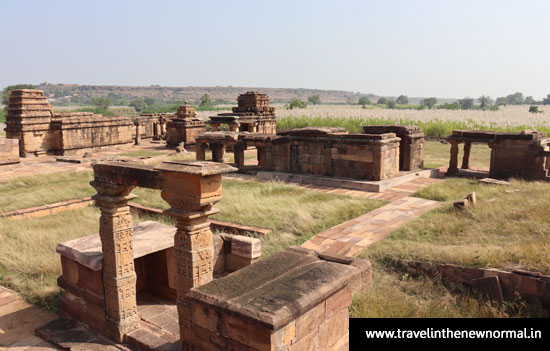 Galaganatha temples group
Galaganatha temples group
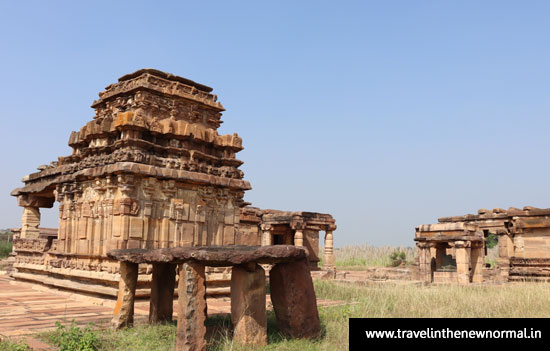 A dolmen, seen in the fore, in the Galaganatha temple complex.
A dolmen, seen in the fore, in the Galaganatha temple complex.
Full
caption
- The builders of the temples did not disturb this megalithic structure, possibly
recognizing that it is in memory of the dead. That is an example of tolerance
we all could learn from.
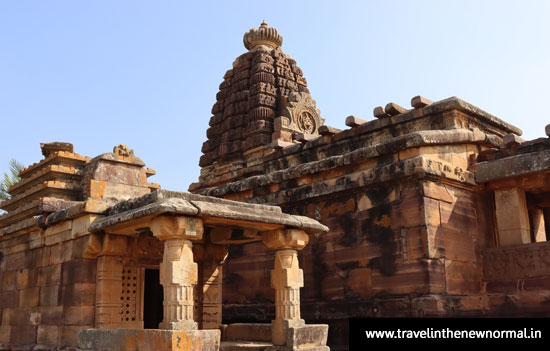 The Mallikarjuna temple complex.
The Mallikarjuna temple complex.
Note the tower of the main temple. It resembles a north Indian shikhara with an amalaka (round serrated crown) and a kalasa on top.
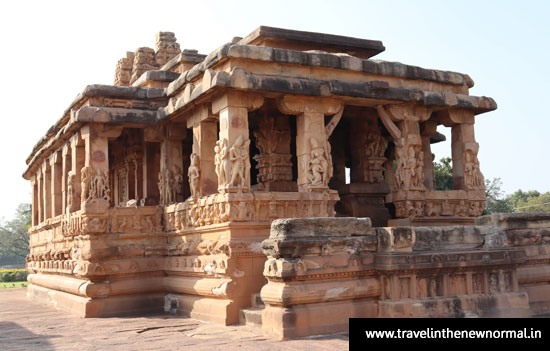 Front view Durga temple.
Front view Durga temple.
Full caption - Made in 742 A.D. The shape reminds one of
Parliament House New Delhi. The
Durg Temple was built by Aatada Ale Komarasingha during the days of
Vikramaditya 2.
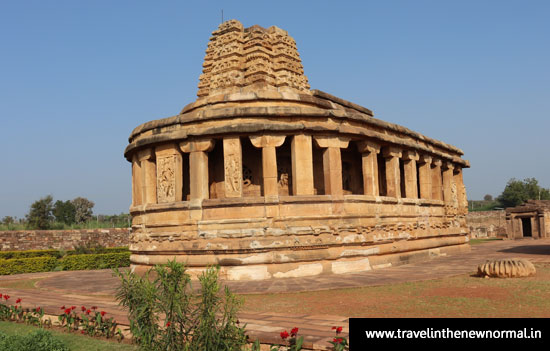 Durga temple with its amalaka or crown lying next to it.
Durga temple with its amalaka or crown lying next to it.
Temple design uncommon in South India.
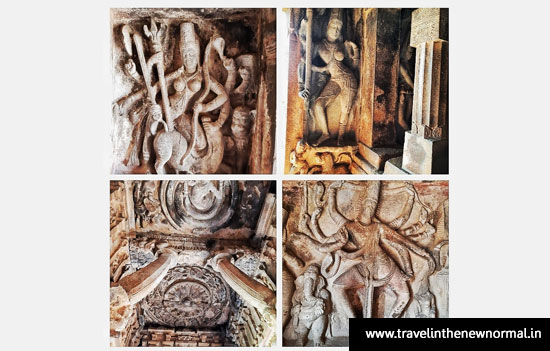 Sculptures in various Aihole temples. Note interesting forms of Hindu deities.
Sculptures in various Aihole temples. Note interesting forms of Hindu deities.
If you thought this
region was all about Chalukyan temple architecture, you are in for a surprise.
There have been discoveries of pre-historic dolmens in and around the region.
There is one isolated dolmen on the way to Pattadakal on the right of the
highway and many on the top of the Meguti hill (the southern face of which has
a Jain cave temple).
Dolmens are megalithic
structures that were built for the departed, generally as a tomb. Modern India
keeps discovering various locations with such structures. Dolmens are commonly
seen in Europe, particularly in the United Kingdom and France. They are also
found in Bastar.
Pattadakal
Temples here mark the blending of the
Rekha-Nagara-Prasada and the South India Vimana styles of temple building.
There are 10 temples of North and South Indian styles. Rest have been ruined by
nature or because of ignorance.
Pattadakal was a religious centre during the days of
early Western Chalukyas from 500-757 A.D. Name of Vikramaditya II is closely
associated with the beautifying of Pattadakal. Jnana Shivacharya, a scholar
from a kingdom north of the Ganga settled down in Pattadakhal indicates the
cultural contact between North and South India then. Some temples have scenes
from the Ramayana for e.g. Ashokvati where Sita was kept captive in Lanka or
Ravana lifting Kailash (also seen in Kailasa Temple Ellora) and army of people
building Ram Sethu to Lanka. Scenes from the Mahabharata too for e.g. birth of
Sri Krishna in jail and Bheesha Pitama sleeping on arrows. Also see Samundra
Manthan (also seen in Bangkok Airport). There is a Kashi Vishveshwara Temple
also.
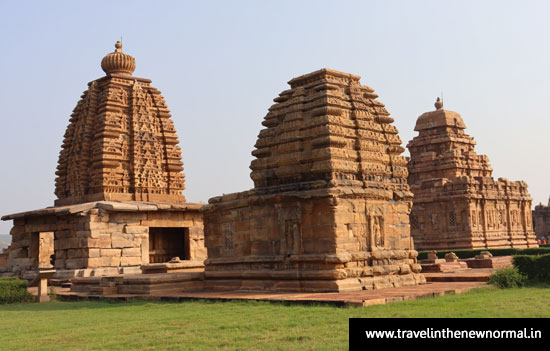 North Indian (Nagara) style, on the left and at the centre, and the south Indian style of the shikharas co-exist.
North Indian (Nagara) style, on the left and at the centre, and the south Indian style of the shikharas co-exist.
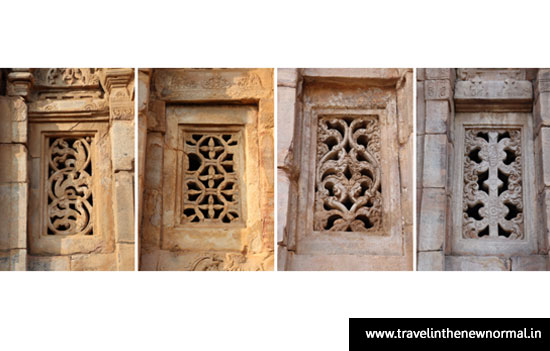 Window “jaali” designs
Window “jaali” designs
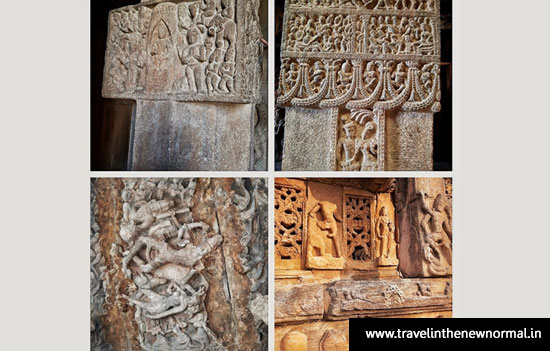 Carvings and panels
Carvings and panels
Badami
Badami was the capital of the Chalukyan Empire (6th
to 8th century A.D.). The town is known for its rock cut temples. Of the 5
caves, 1st is Shiva, 2nd is Vishnu, 3rd is Buddha, 4th is Maha Vishnu, 5th is
Jaina. Like Pattadakal and Bangkok Airport, Samudra Manthan (churning of the
ocean) is found here too.
Cave 1 dedicated to Shiva is the oldest, carved from
solid rock app 550.A.D.
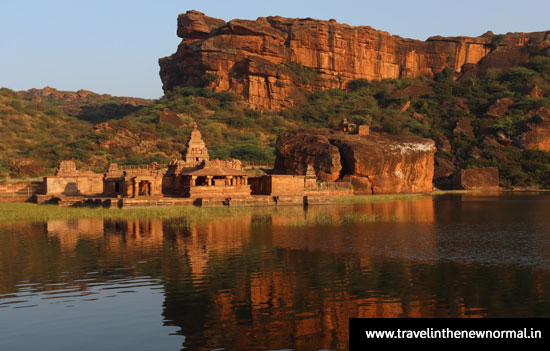 Iconic view of Bhoothanatha temple, Agastya Teertha Lake & sandstone cliff of the northern hills in Badami.
Iconic view of Bhoothanatha temple, Agastya Teertha Lake & sandstone cliff of the northern hills in Badami.
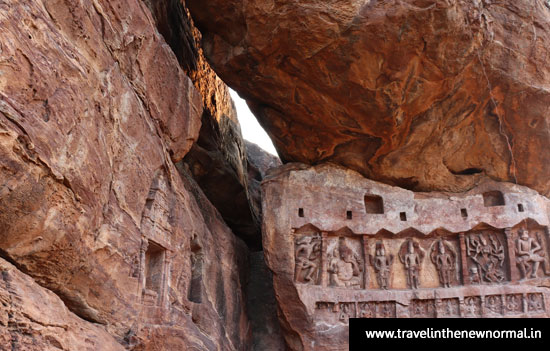 Rock carvings near Bhoothanatha temple.
Rock carvings near Bhoothanatha temple.
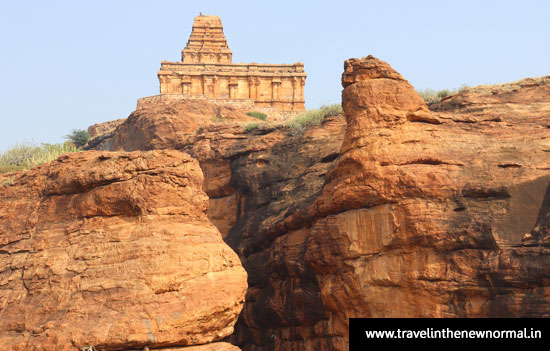 A sandstone cliff and a temple atop make for a delightful visual.
A sandstone cliff and a temple atop make for a delightful visual.
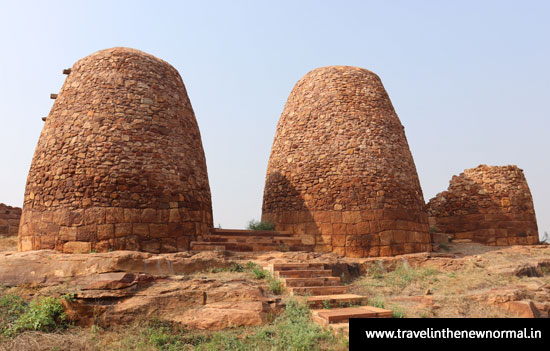 Granaries built during the Mysore Wodeyar or Tipu era.
Granaries built during the Mysore Wodeyar or Tipu era.
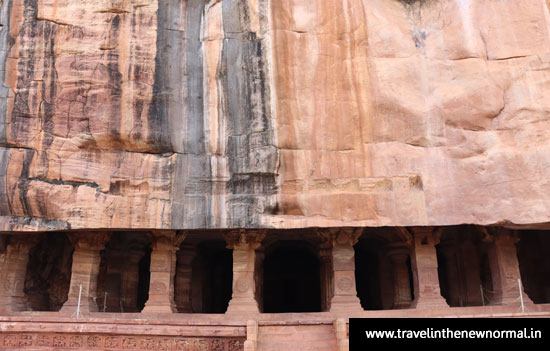 One of the spectacular cave temples
One of the spectacular cave temples
Views
from around the Badami temple complex.
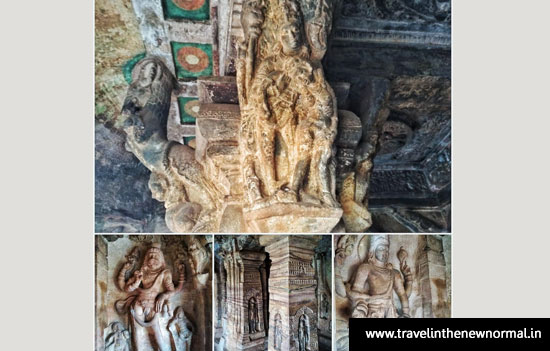 Sculpture rich interiors of cave temples. Some adorned with fresco paintings on ceiling.
Sculpture rich interiors of cave temples. Some adorned with fresco paintings on ceiling.
Details
of pic below. Left to right top is temple corridor. At the end is Maha Vishnu sitting on Adisesha (Serpant). Note pillar design on both left and right. Next pic is of 18 hands Shiva dancing on a lotus. Upper two hands hold a snake and the remaining holding Damaru. The dancing style Shiva exhibits different dancing styles with a display of 18 hands. On left is Nandi nodding performance. Level 3 extreme left is Narasimha's laughing scene after slaying Hiranyakashapu, a demon. The Kamal Pusha (Lotus Flower) is erected on his head decorated with a necklace, tied ornaments in the arms and waist belt. Extreme right pic is Harihara (composite form of Shiva and Vishnu) flanked by consorts Parvati and Lakshmi.
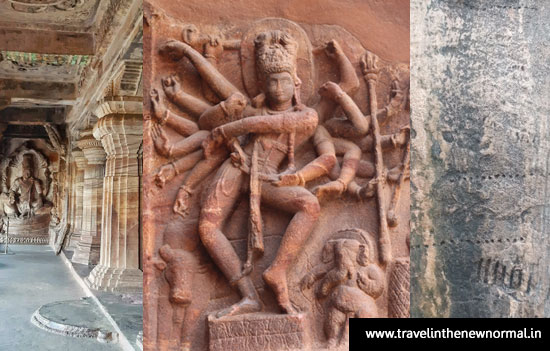 Sculpture rich interiors of the Badami cave temples.
Sculpture rich interiors of the Badami cave temples.
We
missed visiting Badami Fort.
Badami,
the town that serves as the base for travel to this region, does not have too
many options for stay. We stayed in the Heritage Resort, which was a reasonably
spacious property with decent facilities, at least in the cottage category
accommodation that we had chosen to put up in. There are a few other hotels of
fame but this Heritage Resort had the best reviews when we checked. Karnataka
Tourism have a hotel though we did not check it out. It had intrigued me that
the region has such limited accommodations options for tourists.
Once
there, I realized that many people visit Badami, Pattadakal, Aihole in a day
trip from Hampi, which is a good three and a half hours drive each way. I would
strongly discourage visitors to attempt that, as that would do no justice to
the wonders that this region can treat you to. I would recommend that you
reserve one and half to two days for covering these three Chalukyan cultural
bases, if you intend to have a fulfilling trip.
To read all travelogues by author
Author is a Bengaluru
based professional. To visit author’s travel blog
To read all articles in India Travels and Yatras
section
To see
albums of above on esamskriti
1. Aihole
Temples
2. Durg
Temple, Aihole
3. Pattadakal
Temples
4. Badami Caves
5. Badami Fort